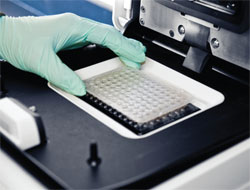



Reservoir of Genetic Diversity Provides Basis for Exciting Future
In this second interview, Dr John Hardiman, new Cobb chief scientific officer, talks to Roger Ranson about the most immediate gains from genomics and looks ahead to the next 25 years. The interview is published in the latest Cobb Focus.
The whole field of genomics is one that’s obviously developing fast as you understand more about individual genes and how they affect performance and behaviour. Where do you see the greatest opportunities in the near future?
Since large numbers of genes normally work in concert to bring about changes in animal performance, we believe technologies that try to measure the effects of large numbers of potential gene markers, al though complex and computer intensive, are the most realistic method of discovering better ways to estimate each bird’s genetic performance value or breeding value. Genome-wide selection is perhaps the best method to do this at this time.
How much is this work going to speed up overall progress, or will you choose to target the more difficult areas to select for, perhaps, traits such as resistance to disease?
Cobb has probably invested more in external research related to this single pursuit than any other trait, simply because of the complexity of selecting for disease resistance and the chance of a negative consequence is more than just a fear. This has meant years of testing, and it sometimes forces you to change targets and tools.
Our research on innate immunity is now entering its eleventh year and we have some very encouraging results. We believe that before long, we may be able to develop enhanced innate immunity with good general resistance to a variety of pathogens both bacterial and protozoa.

You’ve achieved significant improvements in feed efficiency by conventional breeding techniques. How much do you think genomics will add to these gains?
We expect that selection for multiple gene markers proven to be associated with better feed efficiency will be a more effective way of making faster genetic progress in this trait over time. By using more accurate genotypes derived from DNA analysis – as opposed to phenotypes based on bird measurements only – we should eventually be able to make at least 50 per cent more progress in this trait per year.
* "Cobb has probably invested more in external research of disease resistance than any other single trait" |
To some people, genomics conjures up the image of selection based on computer print-outs. How much do you think traditional ‘hands on’ pedigree breeding will continue to play a role in the future?
At any particular time, in a particular environment, there may very well be an outstanding combination of genes that would produce the maximum amount of genetic progress. However, in reality, the genetic composition of lines changes over time – sometimes due to natural genetic changes and sometimes due to changes in feeding, management and health programmes.
With every 2000 chicks that hatch, you’re going to see one or two of these natural changes and that’s part of the variation we use to select on. That’s why, for instance, feather sexing will never be 100 per cent accurate.
The relationships between gene markers and important selection traits must be remeasured periodically – and some people believe continually. This means that we must retain the people and the equipment necessary to carry out a large variety of trait measurements, and also our highly trained experts in physical bird evaluation and hands on selection. Many traits related to bird appearance, behaviour and even welfare will defy effective genomic selection and require the ‘eye of the selector’ for many years to come.

Concerns have been expressed about the shrinkage in the world gene pool for poultry. Do you see this in any way being a limiting factor in the future?
We’re well aware that our livelihood, and that of our customers, depends on continually improving our stocks over time and we wouldn’t intentionally jeopardise diversity within our breeding programmes. We use a variety of methods to help manage diversity in our lines, including careful control of close mating among relatives, using new line crosses to restore diversity and also maintaining over 40 lines ranging from modern white commercial birds to slower growing, coloured lines – each with a wide variety of growth, yield, skeletal and livability traits.
Half of these lines are indeed coloured chickens and they have some interesting genes nothing to do with colour. They provide a reservoir of genetic diversity with genes that we can bring into our products, and of course we’re continually searching for new lines.
John, you’ve been at the helm of the Cobb research programme for almost 25 years. What do you think has been the greatest advance in breeding in that time?
This must be the evolution of faster, more sophisticated and more accurate computer programmes for calculating estimated genetic parameters and breeding values. With the same data we had 25 years ago, we could today make better estimates of each animal’s genetic performance and therefore faster progress on even more selection traits.
* "Breeding companies may form partnerships with feed companies to optimise bird grow-out efficiencies" |
And with your crystal ball, would you speculate for us on the advances we might see in poultry breeding in the next 25 years?
Future customers will probably want parents and broilers of more uniform weight and size to simplify bird management, product sizing and internal production efficiencies. This may mean developing alternative methods of multiplying birds of remarkable uniformity and genetic superiority including advances in semen production. This would also open the door for more customised breeder products. Efficiency of growth and meat production will be critical, so breeding companies may form partnerships with feed companies to develop breeder and feed packages that optimise bird grow-out efficiencies.
Birds must be developed capable of supporting almost eight per cent more yield of breast and leg meat than we have today. Therefore computer-aided imaging and analysis of bird anatomy and movement will likely evolve to allow effective selection of these larger, higher yielding birds. Livability selection may be refined by an improved understanding of the avian immune system as well as new measurements for improved general disease resistance. Production of chicks might be increased by developing very high producing grandparent and parent breeder flocks.
Again computer programmes used for breeding value estimation will improve in speed, and they’ll be able to handle diverse types of traits including those affecting bird behaviour, health and the environment. There’s certainly an exciting future in prospect.
Further Reading
| - | You can view the previous interview with Dr Hardiman by clicking here. |
May 2010








